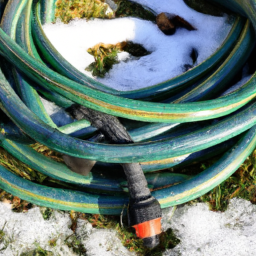How To Keep Garden Hose From Freezing
Table of Contents []
How To Keep Garden Hose From Freezing
Introduction
Gardens and garden hoses provide a place of calming solace during the summer months. Unfortunately, harsher climates can bring frozen hoses and an inability to water the plants. So, how does one extend the usability of the hose outdoors during winter months? The answer comes in a variety of forms that are easy to use and relatively low-cost. In this article, we will explore 8-12 methods of how to keep garden hoses from freezing.
Methods to Keep Garden Hose From Freezing
1. Store the Hose Indoors
When the temperatures drop below freezing, hoses should be brought indoors and stored until warmer weather arrives. This simple solution eradicates the possibility of frozen hoses and water damage.
2. Leave the Water On
When water is left running through a hose, it circulates and provides an internal warmth that can prevent freezing. Ideally, the water should trickle or drip through the hose so that the water does not freeze solid.
3. Thermal Protection
Weak points of hoses that will freeze first are common and can be protected by using thick insulation along hoses' entire length. For instance, gardeners can use insulation such as bubble wrapping, hose sleeves, and simple foam pipe insulation to provide an additional layer of protection. Outside of insulation, garden hoses can be also wrapped in heat lights to create toasty warmth in colder conditions.
4. Permatex
Permatex, a sprayable sealant, is a popular option for insulating hoses from cold temperatures. This protective sealant should be sprayed on the ends of the hose and then allowed to cure. Permatex creates an airtight seal, making it cost-effective and incredibly easy to use.
5. Empty and Drain
One of the most simple and robust methods to prevent hoses from freezing is to empty and drain the hose of water before storing. This step helps to ensure that no water remains inside the length of the hose, which can freeze and are prone to crack.
6. Avoiding Direct Sunlight
UV rays and intense heat can deteriorate hoses over time. By placing the hose in a shaded area or wrapping the hose in cloth, gardeners can avoid direct sunlight while still allowing warmth from the sun to heat the hose indirectly.
7. Mounted Hoses
Storing the hose on an outdoor wall or mounting can help to avoid freezing. By keeping the hose off the ground, the sun can easily heat the length of the hose without relying on the internal temperature of the garden soil.
8. Anti-Freeze Solutions
There are several anti-freeze solutions available that can prevent a garden hose from freezing. Some gardeners opt for solutions that feature a gum and alcohol combination; these solutions can be added to the water that's contained within the hose.
9. Solar Powered Hose Heater
Solar powered hose heaters are a popular choice amongst gardeners. This preventive solution features a silicone heating ribbon that's connected to the inside wall of the hose. The heat sensor is then connected to a solar panel, allowing it to absorb the sun's warmth and provide an internal heat for the length of the hose.
Summary
Gardens and garden hoses provide a sense of tranquility and purpose during the summer months, however, winter monthsespecially in areas with harsher climatescan lead to frozen hoses and water damage. This article has provided 8-12 methods of how to prevent garden hoses from freezing. In order to protect the length of the hose, storing the hose indoors is a simple solution. Alternatively, leaving the water on, utilizing thermal protection, implementing Permatex, emptying and draining the hose, avoiding direct sunlight, mounting the hose, using anti-freeze solution, and solar powered hose heaters are all methods to prevent frozen hoses during the winter months.
Final Thoughts
Taking preventative measures as a gardener resonates with the same type of pride one experiences in the warmer months. Being dependent on the environment doesn't have to be a burden, as this article has evidenced with 8-12 ways to keep garden hoses from freezing.
Conclusion
Gardening experiences are filled with joy and adventure, requiring a certain level of attention and passion for outdoor areas. By utilizing the methods provided in this article, one can extend the usability of the garden hose in harsher climates. Though winter provides colder temperatures, with the right equipment and ideas, frozen hoses are set to become a thing of the past.

Previous Page
